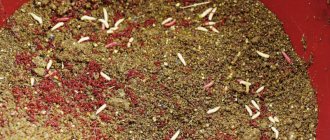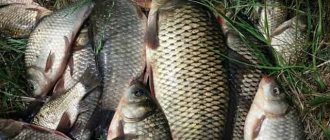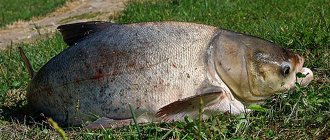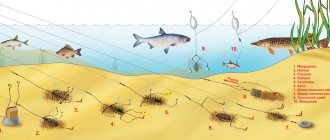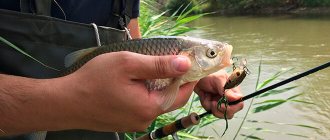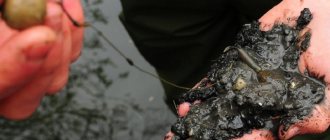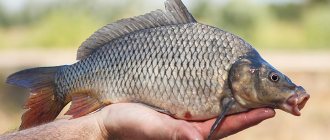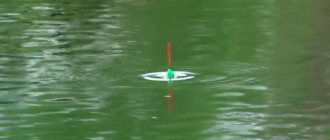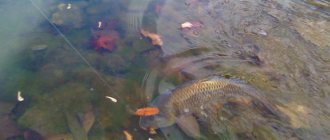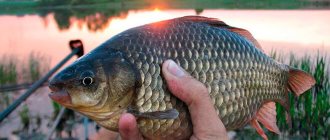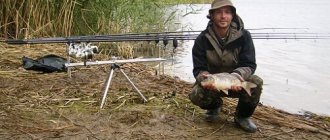Carp is an omnivore, that is, it eats food of plant and living origin. Moreover, he is a great gourmet, because he always chooses tasty and satisfying food. Anglers who compete in carp fishing are therefore constantly trying to choose or invent bait that will dull the vigilance of the carp.
Big fan of corn
Habits of carp
Fish have characteristic behavior only for them, so carp fishing is quite specific. This is not a nocturnal inhabitant of reservoirs like, for example, bream. However, in some cases you can find places where fish are found at night, but only if they are very hungry. Basically, it feeds in the morning and with the onset of evening, and at night it goes deeper.
Carp is a schooling inhabitant of stagnant bodies of water and lives with its relatives. The only exceptions to the rule are single trophy specimens. In a flock it grows up to 10 kg.
It is difficult to catch him because he is capricious in terms of weather:
- Atmosphere pressure;
- wind strength and direction;
- lunar phase;
- temperature in the reservoir.
These are the main indicators that affect the behavior of fish. In our country, carp are effectively caught from early spring from March to September, when the water in the ponds is warm. Severe cold weather will negatively affect the behavior of the fish and the bite will end.
Avid fishermen claim that the most successful time for fishing is cloudy days in the summer without wind.
When does the fish bite start in spring - fishing calendar
Tackle for catching river carp
Since river carp has remarkable strength, tackle must be selected with a certain reserve of power. It's better to buy a carp rod. It is most convenient to use and adapted to the required fishing conditions. You can also use a heavy feeder.
The point here is that fast action is not the best choice, especially when using braided cords. Even if you are fishing for carp on a river, it is better to choose a semi-parabolic feeder. They bend strongly in the current, which negatively affects the sensitivity and visualization of the bite. But the carp bite is often a “locomotive”, so special sensitivity is not required.
To be fair, they are typical when fishing with a blind rig. Savoring boilies or corn, the fish is hooked on its own, and the “locomotive” itself is a consequence of its flight from the scene. When using a sliding rig, you should always be careful when biting, especially if you use a worm, pearl barley or other small bait.
To equip a carp fishing rod, it is better to buy a carp reel with a baitrunner. This will allow you to fish with several rods and not worry that a hooked carp will pull the rod into the water. A baitrunner is also required when a fisherman sets up a tackle for carp in the hope of bycatch, and he himself catches another fish not far away.
If there are no trophy carp in the reservoir, or the angler is always near the rods, then you can save a little and buy an inexpensive carp reel without a baitrunner. But when using such a reel, it is advisable to slightly loosen the clutch after casting.
Choosing a feeder rod and feeder test What is a modern feeder rod or feeder? Categories and feeder test.
Feeder equipment for carp We disassemble the equipment for carp. Options for mounting equipment on carp are inline, helicopter and asymmetrical loop. Choosing a feeder for feeder fishing. Line and hooks are important points.
Where to look for carp
Carp is a heat-loving fish, so in cool water it is inactive and practically does not feed. It is unpretentious to living conditions and can be found in ponds and rivers (wild carp). Until he grows up, he is afraid of predators, and with age he feels imposing, because after 2 years he already weighs more than 1 kg. In the summer, with the onset of heat, it goes to shallow water or to places that have a current.
Carp have been active since March. Fishermen claim that he does not bite until the lilac blooms. Flooded meadows are his favorite place.
It prefers to spend the winter in rivers in pits. At the same time, it produces special mucus that protects it from frost.
In small rivers, fish are found under the bridge if there is significant depth between the piles. The carp also prefers aquatic thickets, feeding near reeds, sucking on algae, on which there are many different living creatures.
Baits
There are not many baits for carp; mainly when catching them they use:
- worms, earth and dung;
- maggot;
- bloodworm;
- caddisfly larvae.
Worms
For lake and pond fishing, the working bait for carp will be a dung worm. The point, it seems to us, is that many carp reservoirs were formed by dams on rivers for the needs of collective farms. On farms there is an abundance of dung worms, which are washed into the pond water by spring flood waters or during heavy summer rainfalls. Therefore, fish in stagnant or low-flowing reservoirs are accustomed to feeding on dung worms, which, apparently, is genetically fixed.
It’s a different matter with fish that live in a medium or large river. Mainly earthworms get here when, during the spring flood, washed-out river banks collapse and whole cubic meters of soil collapse, and with it the worms, fall into the water.
You need to bait your hooks with worms depending on the fishing season. In winter and before spawning, one or two per hook; in summer, when the carp’s mouth is happy with a large piece, a bunch.
Maggot
Maggot, popular among carp fish, is often the answer to the question: what bait to catch carp with. Moreover, you can catch maggots throughout the year.
They bait maggots onto a hook with several larvae at a time: in winter - 2-3 pieces, during the rest of the year the entire hook is filled with larvae. In addition to the simple baiting method, maggot boilies are used and mounted on a hair rig.
The process of making a boilie from maggots:
- The future “hair”: thread or thin fishing line is inserted into a sharp thin needle.
- Carefully place 10-20 maggots onto the hair through a needle, depending on their size and the desired size of the boilie.
- The needle is removed and the hair is tied so that a kind of necklace of maggots is obtained.
- One end of the thread is cut and the other is tied to the shank of the hook. The maggot boilie on a hair rig is ready.
Bloodworm
An indispensable bait for carp and other fish in winter. Bloodworms are the most common food for carp fish, so they do not refuse such a treat. At other times of the year, when using bloodworms, problems arise with the acquisition of mosquito larvae and their storage. And the fish wants to grab a larger piece than a small bloodworm represents.
When fishing for carp, bloodworms are attached with a brush of 5-10 larvae. Often when ice fishing they use it in a sandwich with maggots.
Caddisfly larva
The caddisfly is interesting for fish not only in the larval stage, but also in other phases of its development. The problem with using it as regular bait is related to its prey. Many fishermen would rather buy a worm or maggot at the store than poke around in the mud, looking for caddis, which is very difficult to buy.
Thus, on warm spring days it is worth choosing shallow areas of the reservoir (i.e., no more than one and a half meters deep). The water there warms up faster, thereby attracting carp, which loves to “warm up” after a long winter. Most often he visits such places in the second half of the day. It is definitely worth noting that the most promising fishing spots in reservoirs in the spring are those shallow water areas where fish like to spawn. She will definitely visit them both before spawning and immediately after it.
Preferences of carp in baits and baits by season
Carp are omnivores, so the list of baits that fish bite on is very large. Its activity is significantly influenced by the fishing season.
What do carp bite on in winter?
Many fishermen believe that carp do not bite in winter. But some fishermen often return home with an excellent catch when the weather gets colder. At this time, the fish practically does not resist and is not so demanding for bait, as in the summer season.
If weather conditions are unfavorable, then the carp is in an inhibited state and may not feed for up to one month. Moreover, it is located in driftwood, where it can be found. When the pressure drops, during snowfall or a sudden change in weather, the carp does not bite. During long-term stable pressure, bites are rare, but possible.
There is no strong variety in winter carp gear. Use:
- winter fishing rod with a nod;
- float rod
Some fishermen use fishing rods, similar to girders, but they are ineffective.
Bloodworms are most often used as bait in winter when fishing for carp. The bait is made “poor”, since very little food is needed to saturate inactive fish.
It’s difficult to catch carp in winter, but it’s possible
The basis of bait are:
- ground crackers;
- soils;
- store-bought low-calorie baits without flavorings;
- ground sunflower cake.
Spring fishing
When the ice leaves the reservoir, you can safely go carp fishing. On the river this happens faster and therefore fishing starts earlier here. Exhausted after wintering, the carp is trying to recover; it actively feeds and bites on any bait.
In March, the water is clear and there is no vegetation in the reservoir. Therefore, anglers need to be careful not to spook the carp. He is afraid of bright colors - it is not recommended to use bright things and conspicuous accessories. At the same time, fish do not like noise, so it is necessary to maintain silence.
As for carp gear, they are the same as for fishing in summer and autumn. As a rule, a feeder up to 3.9 meters long, equipped with a spinning reel, is used. A fishing line with a cross section of 0.22-0.28 mm is used, hooks No. 8-10.
In spring, although fish activity begins to increase, carp are reluctant to take very large baits. It is best to use baits of animal origin, of which the worm should be noted separately. This is a universal spring and summer bait that carp always take.
However, there is no need to put worms on the hook in large bunches. One or two is enough. If boilies are used as bait in the spring in March-April, then it is also recommended to choose medium-sized balls; carp do not readily take large baits earlier in the spring.
How to catch carp in May - what spring carp bite on, what baits and baits they prefer:
What to fish for carp in June, July and August
The best period for carp fishing begins in June. If in the spring you should fish in shallow water, then in the summer season you need to fish in holes 3-6 meters deep. Almost all day long the fish tries to hide from the heat in holes, looking for underwater springs where the water is colder. There is everything for him here - shade, food, shelter from predators.
In the summer, fish take bait well in cloudy weather, when there is light rain and little wind, otherwise there will be no bite.
Effective summer carp baits:
- bloodworm;
- corn;
- worm;
- maggot;
- peas;
- pearl barley.
Carp fishing in the summer is complicated by the fact that the fish are constantly moving around the reservoir. Only suitable bait can keep the carp in a certain place.
For example, special formulations sold in stores. You can easily make bait from them, you just need to add them to the water and mix. Of course, bait made at home is also suitable. Attractants are added to working compositions:
- honey;
- anise;
- chocolate;
- halva;
- strawberries;
- garlic;
- parsley;
- raspberries;
- dill.
However, this does not mean at all that by adding one of these smells to the food, you can guarantee a carp bite. Alas, the smell is difficult to guess. Today the fish bites on one scent, and tomorrow chooses a completely different one, and if the fishing takes place on an unknown pond, then this feature is felt quite noticeably.
How and what to catch carp in the summer in June:
Autumn fishing
With the arrival of autumn, carp become sedentary and feed inactively. Often the fish are in the same places as in the summer. In September, she hides in snags or algae.
At this time, carp take bait well on warm days, as they need to replenish their nutrient reserves before wintering. Even frosts at night do not prevent this; the most important thing is that the weather is warm during the day 2-3 days before fishing.
What do you use to catch carp in September-November:
- peas;
- corn;
- pearl barley;
- chickpeas;
- maggot;
- worm;
- caddisfly;
- bloodworm;
- fish boilies;
- mormysh.
Small jigs are used as bait. The
following is used as a base for bait:
- flour products (flour, cookies, biscuits);
- grains (barley, millet, semolina);
- dusty substances (cake, crackers, store-bought fine baits).
Weather for carp fishing
The most favorable weather for carp fishing is rain and thunderstorms. And as a rule, getting wet to the skin is compensated by a good catch. In rainy weather, carp bite best.
He is very sensitive to weather. In prolonged cold weather or hot weather, carp may lose their appetite and stop biting.
You can successfully catch carp throughout the summer. But there are also short breaks. It all depends on the body of water. If carp is successfully caught on one in June, then on the other it can be successfully caught in July and August.
When fishing for carp in the summer, when the water temperature is +20 degrees, it is best to look for it in places where it is cooler. Where there are springs, holes, edges, or walls of reeds that create shadow. How to Catch Carp™© – 5 Secrets
Carp fishing in summer. Video report. Thoughts out loud (Video)
Baits and groundbait for the whole season
The taste of carp varies depending on various factors. When choosing a nozzle, it is necessary to take into account the specifics of the reservoir, season and weather conditions. There are three types of bait:
- animals;
- vegetable;
- special.
The best baits are:
- worms;
- maggots;
- dragonflies;
- caddisflies;
- bark beetles.
Carp bait can be done:
- canned corn;
- steamed peas;
- potatoes;
- barley;
- bread;
- cottage cheese.
Groundbait on peas
Special baits
Nowadays you can find several types of special carp baits in stores. These are pellets and boilies. The latter have the form of balls 6-35 mm in size; they consist of a mixture of different substances that attract carp, attractants and adhesives, and they undergo special heat treatment.
These attachments are attached to a hook or a hair mount. The latter involves placing the boilie next to the hook. This way the fish swallows the bait, which is safe for it, and the hook behind it penetrates the mouth unnoticed.
The hair rig almost always catches the fish by the lip, and therefore the risk of injury is minimal
The boilies certainly contain flour, which acts as the basis of the mixture. Ground cereals, bone meal, betaine, gelatin, and attractants are also added. Boilies are classified according to the following composition:
- fish - based on fishmeal;
- meat - bone meal or dried blood is used;
- sweet – contains caramel and sugar;
- fruit - add grated apples, raspberries, pineapple, pear, etc.;
- spicy - based on vanilla, cumin, garlic, etc.
The ingredients are mixed in the required ratio and boiled or dried until a hard crust appears, which does not allow the bait to quickly become soggy in the water. Taking into account heat treatment, boilies are:
- drowning;
- neutral;
- floating.
The latter are used for fishing in the middle layers of water. These baits have minimal heat treatment, and the top crust appears during drying.
Neutral baits are used for fishing on muddy bottoms. The made balls are boiled to a certain degree, which allows the nozzle not to load or lighten the equipment, so it does not sink into the silt.
Sinking balls are used for fishing on hard bottoms. They have the longest cooking process until the composition is heavy and a crust appears on the surface.
There are also dust boilies that are designed for feeding carp. These balls quickly become limp, creating a haze of nutrient particles. Today you can buy boilies of different types, diameters and purposes. The most popular among fishermen are the following manufacturing companies:
- Tandem Baits;
- Richward;
- Scopex;
- Zoom;
- Dynamite Baits.
Among the attractants used to create boilies, the following have proven themselves to be excellent for carp fishing:
- plum;
- raspberries;
- "octopus";
- banana;
- "skopex".
When you come to a body of water where carp are caught all the time, you should ask the fishermen about their preferred bait.
When independently selecting and preparing different baits, you need to consider that:
- when purchasing canned ingredients for bait or boilies, it is advisable to choose popular manufacturers;
- a maggot stored in a warm room will turn into a pupa in two days;
- when cooking boilies, which are made by hand, they are dipped only in boiling water, otherwise they will simply limp in the water;
- steamed corn, peas, and potatoes should only be stored in the refrigerator and for no more than two days - sour bait will only scare away the fish.
Bait for carp fishing
A few words about bait. To successfully catch carp, you must feed it.
That is, if you are going to catch carp early in the morning, then you should feed the fishing spot in the evening, and if you decide to fish in the evening, then you need to feed it accordingly in the morning.
Wheat, rye, and peas are best suited for bait. But I wouldn’t bother, since now the stores are full of ready-made bait at an affordable price.
Fishing options
During the development of carp fishing, different methods of catching this fish have appeared, which are effective in certain bodies of water, at different distances, at different depths.
Float
The most popular type of fishing. Use float tackle when fishing for carp immediately in the spring, when the reservoir clears up after the ice melts and warms up. But the most effective time to fish with a float is in July. This fishing ends in October with the arrival of frost.
Advantages of float tackle:
- You can effectively catch it when carp spawning ends and the fish are near the shore;
- effective fishing when the carp rises to the surface in the heat to breathe air;
- you can fish in different bodies of water that contain silt, and the spring with the bottom simply falls into the ground.
The float rod is selected and equipped in different ways, this will depend on the size of the carp.
The following types of fishing rods are used:
- plug;
- match;
- max.
To catch carp weighing up to 3 kg, you can choose any of these rods.
Makushatnik
The main element of the equipment is a briquette of compressed corn flour, a product obtained by squeezing sunflower oil.
This topping has a strong, slightly greasy aroma. The “makushatnik” equipment is a lead plate, fishing line and 4 hooks on a leash.
Makushatnik
Pacifier
There are a large number of varieties of pacifiers. The fisherman decides which nipple to use. In this case, the spring contains the bait along with the hooks. It is necessary to use viscous bait. Next, make sure that the equipment falls with the bait down and the hooks towards the top - otherwise the fish will not bite.
The leash is made from a cord approximately 5 cm in size. If you assemble the tackle correctly, then fishing with a nipple always shows good results.
Fishing pacifier
Spring
With this fishing method, the bait can be porridge, dough or other plant food. The equipment in this case is very important - it consists of a spring, which is made of wire with a cross-section of approximately 2 mm.
The spring has the shape of a donut, with a cross-section of about 5 cm. Six leashes are tied to it. The bait is in a spring. At the same time, it must be as viscous as possible in order to completely fill the spring and then stick it on top. 2 hooks are installed in the center of the bait, and the remaining ones are inserted into the porridge located outside.
Spring for catching tench, crucian carp, carp, chub
Feeder fishing
The feeder must include all the main elements, starting from the fishing rod and ending with the attachment of the feeder. The spread of this method of fishing in our country is hampered by the ignorance of many beginners about how to fish with a feeder.
There is another important reason - not all fishermen can purchase a feeder fishing rod and the necessary gear for it, since this is quite an expensive pleasure. When carp fishing on a feeder, special feeders are used.
Feeder fishing involves using a feeder to create a feeding spot at the bottom of the reservoir.
Carp fishing
This is amateur or sport carp fishing, when the basic rule is observed - “catch, release”. The carp fisherman does not take the fish with him, he catches it, takes a photo, treats the wound, and releases it back into the pond.
Carp fishing attachment
Various nozzles are used. For example, professional fishermen prefer to catch carp with boilies. While this bait is not as widespread in Russia as others, it catches excellently, otherwise professionals would not use it.
Popular baits today are: potatoes, earthworms, peas, bread, corn.
Recommendations for carp fishing
Successful fishing requires the best conditions:
- muddy water with weak current;
- before weather conditions improve, when the weather is cloudy and lightly drizzling.
How to experiment with carp:
- use different baits, since this is an unpredictable fish;
- change the composition of the bait mixture.
Carp fishing brings many pleasant moments and pleasure to all fishermen. These recommendations, which are described above, are just the tip of the iceberg of methods used by experienced fishermen.
